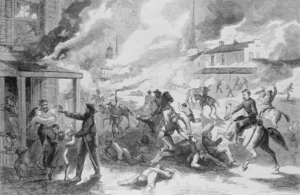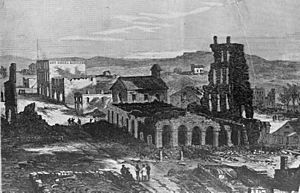Lawrence Massacre facts for kids
Quick facts for kids Lawrence massacre |
|||||||
|---|---|---|---|---|---|---|---|
| Part of the American Civil War | |||||||
 An artist's drawing of the destruction of Lawrence, Kansas, and the massacre of its people by Confederate guerrillas on August 21, 1863 |
|||||||
|
|||||||
| Belligerents | |||||||
| Commanders and leaders | |||||||
| None | William C. Quantrill | ||||||
| Units involved | |||||||
| Civilian population of Lawrence Unmustered recruits |
Quantrill's Raiders | ||||||
| Strength | |||||||
| 0 | 300–400 | ||||||
| Casualties and losses | |||||||
| 164 civilians | 40 | ||||||
The Lawrence Massacre, also known as Quantrill's Raid, was a surprise attack on the town of Lawrence, Kansas on August 21, 1863. This event was a part of the U.S. Civil War. A group of guerrillas (fighters who use surprise attacks) from the Confederate side, led by William Quantrill, rode into Lawrence. They caused a lot of damage and killed many people. About 150 men and boys were killed during this attack.
Lawrence was chosen as a target because it strongly supported abolition (ending slavery). It was also a main base for the Jayhawkers. These were free-state militia (citizen soldier) groups known for attacking plantations in western Missouri, a state that supported slavery.
Contents
Why did the Lawrence Massacre happen?
By 1863, Kansas had already seen a lot of fighting. This was because people strongly disagreed about whether Kansas should allow slavery or not. This period of violence was known as "Bleeding Kansas."
In 1856, the first sacking of Lawrence (meaning it was attacked and robbed) began a long guerrilla war in Kansas. Many groups fought for each side during this time. John Brown, an abolitionist who fought against slavery, was one of the most famous people involved.
By the start of the American Civil War, Lawrence was already a target for pro-slavery groups. It was seen as the main anti-slavery city in Kansas. It was also a starting point for attacks by Union soldiers and Jayhawkers into Missouri. At first, the town was ready for attacks. But by the summer of 1863, people felt safer because no attacks had happened. So, the town's defenses were not as strong.
Revenge for Jayhawker attacks
Lawrence was a headquarters (main base) for a group of Jayhawkers. These Jayhawkers, sometimes called "Red Legs," had started attacking Confederate guerrillas in Missouri in early 1863. A Union General named Blunt said that these Jayhawker actions led to "a reign of terror." This meant that people's property was not safe, and their lives were in danger if they tried to stop the Jayhawkers from robbing and stealing.
Many Jayhawker leaders, like Charles "Doc" Jennison and James Montgomery, attacked western Missouri. This made both pro-southern and pro-Union people in Missouri very upset. Historians believe that revenge was the main reason for Quantrill's attack on Lawrence. The Jayhawkers also wanted to steal, but revenge was a strong motive.
Survivors of the Lawrence Massacre confirmed that revenge was a big part of the attack. Quantrill himself said his reason was "to steal and destroy the town as revenge for Osceola." He was talking about the Union's attack on Osceola, Missouri, in September 1861. That attack was led by Senator James H. Lane. Osceola was plundered (robbed), and nine men were quickly put on trial and executed (killed).
How the attack happened
A man named Henry Thompson tried to warn Lawrence about the coming attack. He ran all the way to Eudora before he was too tired to go on. An unknown man helped him, and they managed to get some people from Eudora to ride to Lawrence to give the warning. However, they were too late.
Around 450 guerrillas arrived near Lawrence just after 5 a.m. Their first goal was to take control of the Eldridge House, a large brick hotel in the center of Lawrence. This hotel became Quantrill's headquarters during the raid. After securing the hotel, Quantrill's men split into smaller groups and spread out across Lawrence.
For the next four hours, the raiders pillaged (robbed) and burned about 25% of the buildings in Lawrence. Almost all businesses were burned down. They also robbed most of the banks and stores in town. They killed more than 150 people, all of whom were men and boys. Some reports say 183 people were killed. Among the dead were 18 of 23 army recruits who had not yet officially joined the army. By 9 a.m., the raiders began leaving Lawrence.
The raiders had a list of people they wanted to kill and buildings they wanted to burn because they were seeking revenge. James H. Lane was at the top of this list. Lane was a military leader and a strong supporter of the Jayhawkers. He had led raids that killed people and destroyed property in western Missouri early in the Civil War. Lane managed to escape by running through a cornfield while wearing his nightshirt. John Speer, who owned a newspaper and was a big supporter of Lane, was also on the list. Charles L. Robinson, the first governor of Kansas and an abolitionist, may also have been on the list, but he was not killed.
Many people have pointed out that Quantrill's choice to kill young boys along with adult men was a particularly terrible part of the attack.
What happened after the attack?

The Lawrence Massacre was one of the most violent events in Kansas history. The Plymouth Congregational Church in Lawrence was not destroyed, but many of its members were killed, and many church records were lost.
After the attack, Quantrill took his men south to Texas for the winter. However, by the next year, the raiders broke up as a single fighting group. They were not able to have similar successes again. Quantrill himself died from wounds he received in Kentucky in 1865. By that time, he had only a few supporters left, including Frank James and his younger brother, Jesse James.
After Quantrill's attack, the Union built several military posts on Mount Oread. These were meant to help protect the rebuilt city. However, no more attacks happened in Lawrence, so these forts were later removed.
Related pages
- Bushwhacking a kind of guerrilla warfare used a lot during the American Revolutionary War, American Civil War
See also
 In Spanish: Masacre de Lawrence para niños
In Spanish: Masacre de Lawrence para niños

